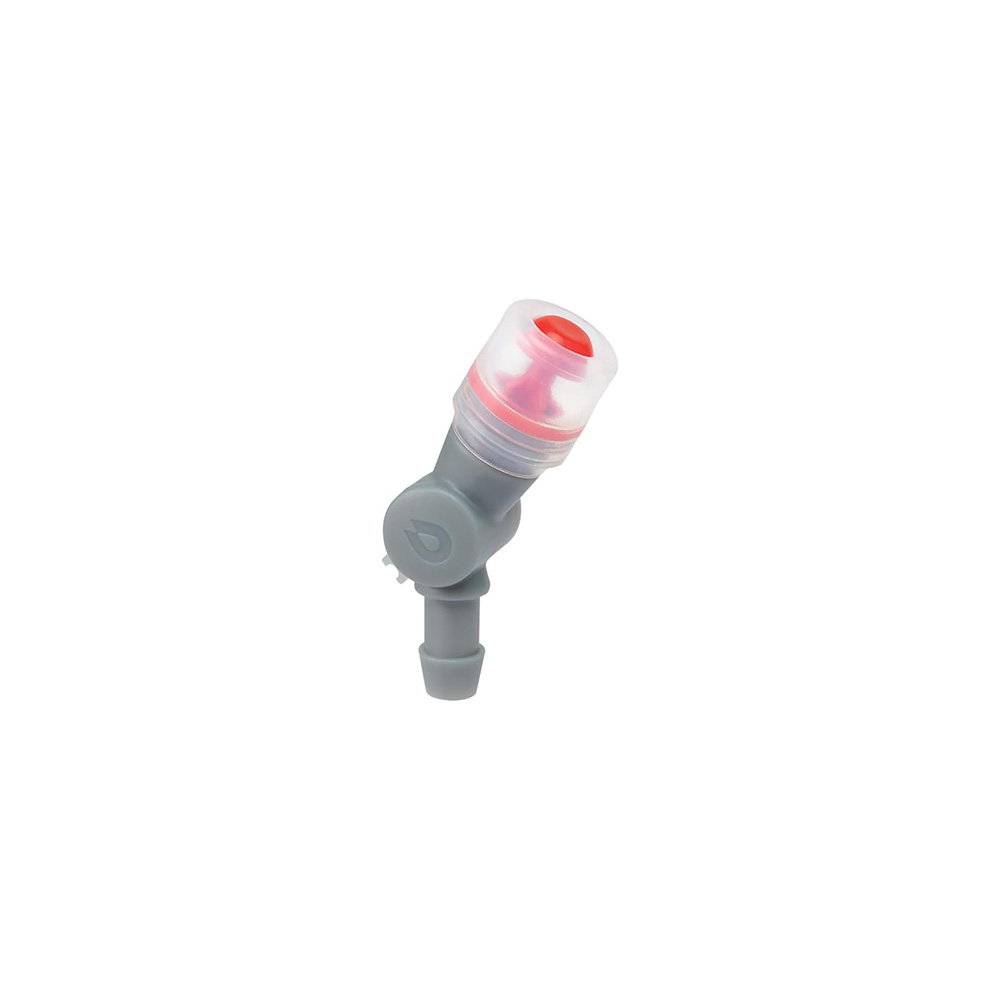
To prevent a hydration pack bite valve from leaking, follow these steps:
- Inspect the bite valve for cracks or damage.
- Clean the bite valve and hydration pack regularly.
- Check the bite valve positioning to ensure a tight seal.
- Adjust the bite valve orientation to prevent accidental leaks.
- Replace the bite valve if necessary to maintain a leak-free hydration system.
Troubleshooting Water Bladders
Inspect the Bite Valve
Check the Bite Valve for visible damage, dirt, or debris causing leaks. If you spot any issues, clean the valve thoroughly using mild soap and warm water. Gently scrub the valve to remove any buildup or blockages. Rinse with clean water and allow it to air dry before reattaching it to your hydration pack.
Ensure Proper Assembly
- Check that the bite valve is tightly fastened to the hydration pack tube. Make sure to align it.
- Confirm that all connections are tightly secured to prevent any leaks during its use.
- Ensure there are no twists or kinks in the tubing that may disrupt the flow of water.
- Test the assembly by giving the bite valve a gentle pull to make sure it’s in place.
Adjust the Valve Position
- Position the valve in a straight line with the tube to prevent kinks or bends.
- Ensure there are no twists in the tube where it connects to the valve.
- Avoid sharp angles or loops when setting up the valve to prevent potential leaks.
Follow these steps. They maintain a secure valve-tube connection, eliminating potential problems.
Check the Seal
Inspect the rubber seal around the valve carefully for any signs of wear or damage. Look for cracks, tears, or areas where the seal is not properly sealing. If you notice any issues with the seal, replace it with a new one to ensure a tight and secure fit. This simple step can help prevent leaks and ensure optimal performance of the valve.
Maintain Cleanliness
Remove the bite valve from your hydration pack for cleaning and sanitizing. Take apart the valve by unscrewing its parts. Wash them with gentle circular motions in warm, sudsy liquid. Remove residue with a thorough rinse. Wait for it to dry before putting it back together. This maintenance will prevent clogs and buildup. It’s going to ensure a leak-free adventure.
Avoid Over-tightening
- Carefully tighten the valve onto the tube until you feel resistance.
- Stop twisting once resistance is felt; do not continue forcing the valve.
- Over-tightening can harm the seal, leading to potential leaks.
Use Protective Cover
- When your bite valve is not in use, cover it with a protective cap to prevent damage and leaks.
- Check your backpack or hydration pack for a spare bite valve cover. If one is not available, consider purchasing a replacement or using a small container to cover the valve securely.
- Place the protective cover over the bite valve and ensure it is securely fastened to avoid any potential leaks.
- Regularly inspect the protective cover to ensure it is in good condition and providing adequate protection for your bite valve.
Test for Leaks
- Before each use, suck on the bite valve to check for leaks.
- Ensure the valve is closed and then suck to create suction.
- Listen for any unusual air hissing sound, indicating a leak.
- Address any leaks promptly to ensure your hydration system functions effectively.
Replace Faulty Parts
After following these steps, if the bite valve still leaks, replace it or other faulty parts.
- Inspect the bite valve and surrounding components for any signs of wear or damage.
- Purchase a replacement bite valve or relevant parts from the manufacturer or a reputable retailer.
- Follow the manufacturer’s instructions to properly install the new valve or component to ensure a secure and leak-free fit.
Wrap-Up and Final Tips
It seems like you’ve nailed the conclusion with a perfect summary! Doing those steps will help. They will keep your hydration pack’s bite valve from leaking during outdoor activities. Great job!
Necessary Supplies
Preventing Leaks
Properly Utilizing Your Hydration Pack’s Bite Valve for Optimal Hydration
- Fill the hydration pack with water to its precise capacity.
- Fix the valve to the hose with a reliable connection.
- Put the bite valve where it’s easy to reach near your mouth. Do this while wearing the hydration pack.
- Bite down on the valve to release the water’s flow when you’re ready.
- Suck on the valve to drink water, and release the bite pressure to stop the flow.
Bite Valve Usage Tips
Yes, you must clean the bite valve often. It prevents bacteria buildup and keeps good hygiene. Cleaning often. It can stop germs from spreading. It also keeps your equipment safe. Follow the maker’s cleaning and maintenance guidelines. They keep your gear in top shape.
Yes, there are various types of bite valves available for hydration packs. Some common options include standard, high-flow, and twist-lock valves. These types cater to individual preferences. They vary in flow rate, ease of use, and leak prevention. It’s worth exploring the features of each type to find the one that best suits your needs and activities.
Valves in bite tubes develop holes, allowing liquid to escape. They are hard to open or close. They also get mold. To troubleshoot these issues, you can try cleaning the valve well with warm soapy water. Use a small brush to remove any debris. Check for tears or damage in the valve. Also, make sure all parts align during assembly. If the issue continues, you may need to replace the bite valve. This will ensure it works well.
You can adjust the flow of water through the bite valve of your hydration pack or water bottle. You can do this by pinching the bite valve with your teeth or fingers. By varying the pressure applied, you can regulate how much water comes out when you bite down on the valve. This technique allows you to set the flow rate to your liking. It ensures you stay hydrated without wasting water. Remember to test it out before your activity to find the right pressure for your preferred flow rate.
To prevent leaks from the bite valve on your hydration pack or water bottle, make sure to seat the valve well. Secure the device to the hose with a tight seal. Make sure the valve is clean and free from debris that could interfere with its sealing function. Examine the valve and hose frequently to detect wear or damage signs. Close the valve securely when not in use to prevent leakage. Following these steps will help you reduce leaks. They will also ensure your hydration system works well.
When it comes to biting on the valve of a water bottle to drink efficiently, there are a few techniques you can use. One effective method is to gently squeeze the bottle with your teeth as you bite down on the valve. This helps control the flow of water and prevents spillage. Also, try to point the valve toward the roof of your mouth. This allows the water to flow well. Experiment with different pressure levels. Find the right balance to get water fast without wasting any. Remember, practice makes perfect!
Yes, you can customize the length of the hose attached to the bite valve by cutting it to your desired length. Just make sure you have the right tools to cut the hose cleanly and neatly. Remember to measure and mark the hose before cutting to ensure the perfect fit for your needs.
To clean a hydration pack’s bite valve, first carefully detach it from the hose. Next, rinse the bite valve and the hose with warm, soapy water. Use a small brush, like a pipe cleaner or a toothbrush. Use it to scrub the inside of the valve and hose. This will remove any built-up residue. Rinse carefully and let parts dry fully before reattaching. You can also use a special cleaning kit for hydration packs. It removes every last trace of dirt. Follow these steps often. They will keep your hydration pack’s bite valve clean and working well.
To prevent mold from growing in the bite valve of your water bottle, it’s essential to clean it regularly and thoroughly. Here are some steps you can follow:
- After each use, rinse the bite valve with hot, soapy water.
- Use a small brush, like a toothbrush or a pipe cleaner, to scrub the inside of the bite valve to remove any residue.
- Allow the bite valve to air dry completely before storing it.
Also, make sure to empty your bottle completely when not in use. This prevents moisture buildup, which can cause mold. Remove moisture from the bite valve regularly to block mold formation. Then, you can use your water bottle without worry.
Hydration pack bite valves are often made from materials like silicone. They are also made from TPU (Thermoplastic Polyurethane). They can also be made from medical-grade plastics, like food-safe thermoplastic elastomers. We chose these materials because they are durable and flexible. They are safe for drinking water and can handle lots of use and cleaning.
Yes, you can use the bite valve with drinks other than water. But, some drinks may leave residue or flavor in the valve. This could affect the water’s taste later. Clean the valve well if you switch between drink types. This stops bad tastes and bacteria.












 Home
Home  Blog
Blog
Test the hydration pack with water before every use to check for any leaks.
Make sure the bite valve is properly screwed on to prevent leaks.
Check if there are any visible cracks or damage on the bite valve that could be causing leaks.
Consider using a cover for the bite valve to protect it from dirt and dust which can contribute to leaking.
Avoid over-tightening the bite valve as it can damage the seal and lead to leaks.
Inspect the entire hydration pack system for any other potential sources of leaks.
Try lubricating the bite valve with silicone grease to create a better seal and prevent leaks.
Seek advice from other users who have successfully prevented leaks in their hydration pack bite valves.
Ensure the hose connection is secure as sometimes leaks can occur from there.
Clean the bite valve regularly to prevent clogs that may lead to leaks.
Try replacing the O-ring to see if that helps with the leaking issue.
Make sure the bite valve is compatible with the hydration pack to ensure a proper fit.
Consider investing in a higher quality bite valve to minimize the chances of leaks.
Store the hydration pack carefully to avoid any pressure on the bite valve that could cause leaks.
Contact the manufacturer for guidance if you are still experiencing leaking issues despite trying various solutions.